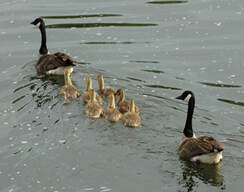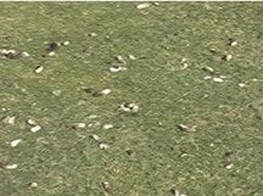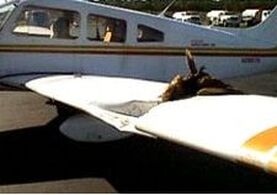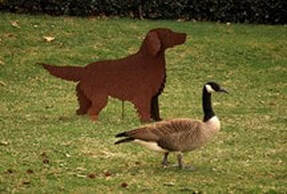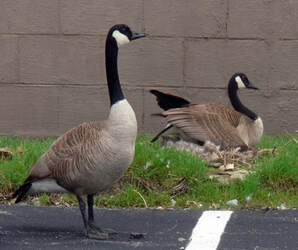
Natural History
Canada Geese have always been present in the state of New York in some numbers. They are a large bird with tan bodies and black heads with a white chinstrap. Geese harbor a 50 to 67 inch wingspan, and can weigh between 6 and 20 pounds. There are 11 recognized subspecies of Canada geese, and most are determined by body size and breeding habitat. Geese are herbivorous and dine on a variety of plant materials. These foods include grasses, seeds, berries, aquatic plants, and especially agricultural grains. Canada geese mate for life, and they begin nesting in April in most of New York. The female lays between 2 and 8 white eggs, and she incubates them for about 25 days before hatching occurs. The goslings are born yellowish in color and quickly grow over several months in order to be ready for the fall.
Two distinct populations of geese are present in New York; migratory and resident. The migratory birds nest in Canada and journey to the southern United States to wintering grounds. They are usually only present for short periods of time in the spring and fall as they migrate. The resident population is present year round, moving only short distances or not at all during the winters. These are usually the geese found at parks, ponds, and golf courses during the summer and winter. Resident birds are most often the ones considered to be “nuisances”.
Canada geese w/ goslings on a pond.
Legal Status
Canada geese are regulated federally by the United States Fish and Wildlife Service. They can be hunted for a certain period of time during the fall each year, while during the rest of the year they are considered protected. Due to the recent boom in resident geese, the USFWS has given the individual states some power to deal with their nuisance birds. These regulations vary by state and often give people options for goose removal during non-hunting seasons. New York State’s regulations will be further explained later in this document.
Population Trends
The migratory Canada geese in New York are traveling in the Atlantic Flyway. These geese were nearly extirpated from many areas years ago by uninhibited hunting and habitat degradation, and they were re-introduced and propagated in many eastern areas. The population then rebounded to levels around 900,000 birds. The population of geese in this flyway then declined dramatically in the late 80’s and early 90’s, but has rebounded somewhat and is currently holding steady around 550,000 birds. The decline was due to poor nesting seasons and poor management by agencies and hunters.
The resident goose population has literally exploded, with some estimates around 1.5 million birds in the eastern states. This can be attributed to more areas being closed to hunting, mild winters, increase in suitable resident habitat, and the absence of predators. These geese are also not subjected to the rigors of a long seasonal journey like their migratory counterparts and have a higher survival rate.
Canada Geese as a Nuisance
Canada geese exhibit many behaviors that can cause them to become nuisances. One major problem geese cause is their droppings on golf courses and other public areas where they congregate. This can be just an inconvenience, or it can cause serious water quality problems and health concerns. Nesting geese can be very aggressive towards pets and pedestrians who come too close to their nests and young. In large numbers Canada geese can cause crop damage to some grain and grass crop types. Another major problem geese cause is with the aviation industry. A single airborne goose can bring a plane down as well as cause loss of life or millions of dollars in damages to aircraft.
Geese and Aircraft
As mentioned, geese pose a huge threat to aircraft. Their large body size and the fact that they often travel in flocks make them extremely dangerous to planes. Often when a strike occurs it involves multiple birds hitting a plane. Millions of dollars of damages are incurred yearly by aircraft colliding with Canada geese, and many emergency landings are forced due to strikes as well. Airports that have more goose activity in the surrounding areas have a much greater risk than airports located in areas with few goose attractants and areas.
Management of Geese
There are a number of techniques that can be employed when trying to deal with nuisance goose populations. The easiest form is to manage the habitat so that it is unsuitable to geese. Where it is possible the grass can be left long to discourage loafing of geese, and certain woody plants may be planted to obstruct their view of approaching predators. With the proper permit a chemical can also be applied to grasses that make it unpalatable to geese. If geese establish a nest, the owners may addle or oil the eggs to prevent hatching. Adult geese hanging around unwanted locations can be hazed using a variety of techniques. One option is using visual deterrents such as Mylar tape and predator decoys. This is often only effective for a short time before they become habituated. Pyrotechnics can be used to scare away geese, but this too can be time consuming and ineffective after time. Also, trained dogs may be used to scare off unwanted birds on ponds and golf course where they create issues. Where applicable, land owners may decide to allow hunting on their property to try and disperse and harvest some of their problem birds. If a number of these techniques are employed and the desired result still is not achieved, then lethal control may be sought via a permit from either the NYSDEC or USFWS.
NYS and USFWS Permits Explained
The NYSDEC and the USFWS both have a hand in regulation resident Canada geese, and this is an overview of the regulations and permits regarding control work.
Scaring, herding, and/or hazing of geese does not require any sort of permit from either agency as long as no birds are injured or killed.
Nests and eggs may be destroyed or addled in any number on property by owners or managers under the NYSDEC’s General Depredation Permit. However, before any action takes place the person must register online with the USFWS at https://epermits.fws.gov/eR C G R /. This is valid March 1st – June 30th each year, and actions taken must be reported by Oct. 31st each year, even if no nests were disturbed. A copy of the permit received from this website must be printed out, signed, and carried during all nest and egg actions.
Adult and juvenile birds can be taken under the NYSDEC’s GDP only if an applicable federal permit is attained or the actions fall under the three federal control orders that exempt managers from holding permits. These federal control orders are: Control order for Canada geese at airports and military air fields (50 CFR 21.49),Depredation order for Canada geese at agricultural facilities (5 0 C FR 2 1 .5 1 ),and the Public health control order for Canada geese (50 C FR 2 1 .5 2 ).
Managers acting under the federal airport control order must follow some guidelines as well. Airport managers or their employees may take any number of nests, eggs, or geese on or within 3 miles of the airport boundaries without a federal or state permit. This applies April 1st- Sept 15th for adults, and March 1st-June 30th for eggs. Any actions off actual airport property must be reported to the NYSDEC 24 hours in advance of management actions. To qualify for this order, the airport has to be in the National Plan of Integrated Airport Systems and have received federal grant- in-aid assistance, or be a military airport. Airport managers must submit a yearly report of all geese and nests taken to the USFWS by Dec. 31st annually.
Additional information and questions can be reviewed at http://www.dec.ny.gov/docs/wildlife_pdf/nygoosepermitinfo.pdf, and state and federal agencies should be consulted prior to any adult bird management actions to avoid confusion.
Canada Geese have always been present in the state of New York in some numbers. They are a large bird with tan bodies and black heads with a white chinstrap. Geese harbor a 50 to 67 inch wingspan, and can weigh between 6 and 20 pounds. There are 11 recognized subspecies of Canada geese, and most are determined by body size and breeding habitat. Geese are herbivorous and dine on a variety of plant materials. These foods include grasses, seeds, berries, aquatic plants, and especially agricultural grains. Canada geese mate for life, and they begin nesting in April in most of New York. The female lays between 2 and 8 white eggs, and she incubates them for about 25 days before hatching occurs. The goslings are born yellowish in color and quickly grow over several months in order to be ready for the fall.
Two distinct populations of geese are present in New York; migratory and resident. The migratory birds nest in Canada and journey to the southern United States to wintering grounds. They are usually only present for short periods of time in the spring and fall as they migrate. The resident population is present year round, moving only short distances or not at all during the winters. These are usually the geese found at parks, ponds, and golf courses during the summer and winter. Resident birds are most often the ones considered to be “nuisances”.
Canada geese w/ goslings on a pond.
Legal Status
Canada geese are regulated federally by the United States Fish and Wildlife Service. They can be hunted for a certain period of time during the fall each year, while during the rest of the year they are considered protected. Due to the recent boom in resident geese, the USFWS has given the individual states some power to deal with their nuisance birds. These regulations vary by state and often give people options for goose removal during non-hunting seasons. New York State’s regulations will be further explained later in this document.
Population Trends
The migratory Canada geese in New York are traveling in the Atlantic Flyway. These geese were nearly extirpated from many areas years ago by uninhibited hunting and habitat degradation, and they were re-introduced and propagated in many eastern areas. The population then rebounded to levels around 900,000 birds. The population of geese in this flyway then declined dramatically in the late 80’s and early 90’s, but has rebounded somewhat and is currently holding steady around 550,000 birds. The decline was due to poor nesting seasons and poor management by agencies and hunters.
The resident goose population has literally exploded, with some estimates around 1.5 million birds in the eastern states. This can be attributed to more areas being closed to hunting, mild winters, increase in suitable resident habitat, and the absence of predators. These geese are also not subjected to the rigors of a long seasonal journey like their migratory counterparts and have a higher survival rate.
Canada Geese as a Nuisance
Canada geese exhibit many behaviors that can cause them to become nuisances. One major problem geese cause is their droppings on golf courses and other public areas where they congregate. This can be just an inconvenience, or it can cause serious water quality problems and health concerns. Nesting geese can be very aggressive towards pets and pedestrians who come too close to their nests and young. In large numbers Canada geese can cause crop damage to some grain and grass crop types. Another major problem geese cause is with the aviation industry. A single airborne goose can bring a plane down as well as cause loss of life or millions of dollars in damages to aircraft.
Geese and Aircraft
As mentioned, geese pose a huge threat to aircraft. Their large body size and the fact that they often travel in flocks make them extremely dangerous to planes. Often when a strike occurs it involves multiple birds hitting a plane. Millions of dollars of damages are incurred yearly by aircraft colliding with Canada geese, and many emergency landings are forced due to strikes as well. Airports that have more goose activity in the surrounding areas have a much greater risk than airports located in areas with few goose attractants and areas.
Management of Geese
There are a number of techniques that can be employed when trying to deal with nuisance goose populations. The easiest form is to manage the habitat so that it is unsuitable to geese. Where it is possible the grass can be left long to discourage loafing of geese, and certain woody plants may be planted to obstruct their view of approaching predators. With the proper permit a chemical can also be applied to grasses that make it unpalatable to geese. If geese establish a nest, the owners may addle or oil the eggs to prevent hatching. Adult geese hanging around unwanted locations can be hazed using a variety of techniques. One option is using visual deterrents such as Mylar tape and predator decoys. This is often only effective for a short time before they become habituated. Pyrotechnics can be used to scare away geese, but this too can be time consuming and ineffective after time. Also, trained dogs may be used to scare off unwanted birds on ponds and golf course where they create issues. Where applicable, land owners may decide to allow hunting on their property to try and disperse and harvest some of their problem birds. If a number of these techniques are employed and the desired result still is not achieved, then lethal control may be sought via a permit from either the NYSDEC or USFWS.
NYS and USFWS Permits Explained
The NYSDEC and the USFWS both have a hand in regulation resident Canada geese, and this is an overview of the regulations and permits regarding control work.
Scaring, herding, and/or hazing of geese does not require any sort of permit from either agency as long as no birds are injured or killed.
Nests and eggs may be destroyed or addled in any number on property by owners or managers under the NYSDEC’s General Depredation Permit. However, before any action takes place the person must register online with the USFWS at https://epermits.fws.gov/eR C G R /. This is valid March 1st – June 30th each year, and actions taken must be reported by Oct. 31st each year, even if no nests were disturbed. A copy of the permit received from this website must be printed out, signed, and carried during all nest and egg actions.
Adult and juvenile birds can be taken under the NYSDEC’s GDP only if an applicable federal permit is attained or the actions fall under the three federal control orders that exempt managers from holding permits. These federal control orders are: Control order for Canada geese at airports and military air fields (50 CFR 21.49),Depredation order for Canada geese at agricultural facilities (5 0 C FR 2 1 .5 1 ),and the Public health control order for Canada geese (50 C FR 2 1 .5 2 ).
Managers acting under the federal airport control order must follow some guidelines as well. Airport managers or their employees may take any number of nests, eggs, or geese on or within 3 miles of the airport boundaries without a federal or state permit. This applies April 1st- Sept 15th for adults, and March 1st-June 30th for eggs. Any actions off actual airport property must be reported to the NYSDEC 24 hours in advance of management actions. To qualify for this order, the airport has to be in the National Plan of Integrated Airport Systems and have received federal grant- in-aid assistance, or be a military airport. Airport managers must submit a yearly report of all geese and nests taken to the USFWS by Dec. 31st annually.
Additional information and questions can be reviewed at http://www.dec.ny.gov/docs/wildlife_pdf/nygoosepermitinfo.pdf, and state and federal agencies should be consulted prior to any adult bird management actions to avoid confusion.
